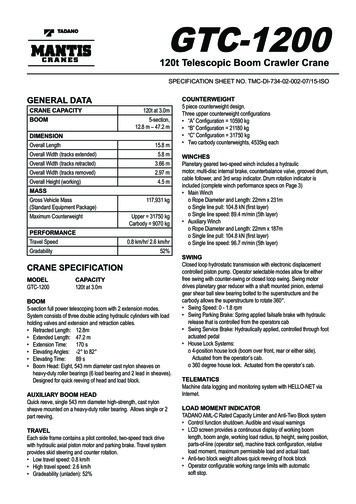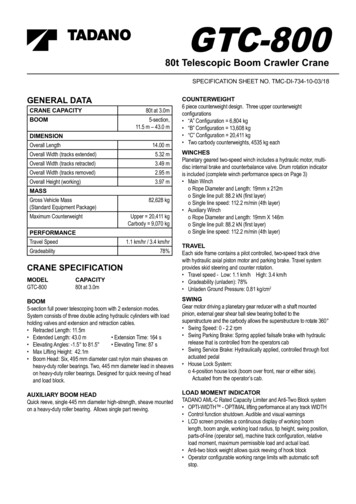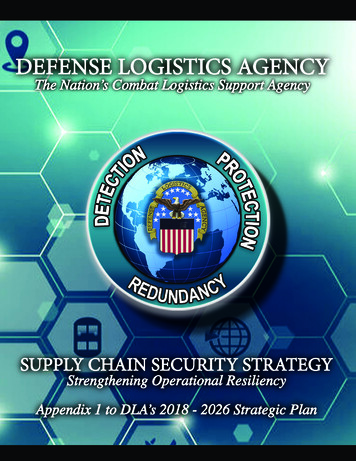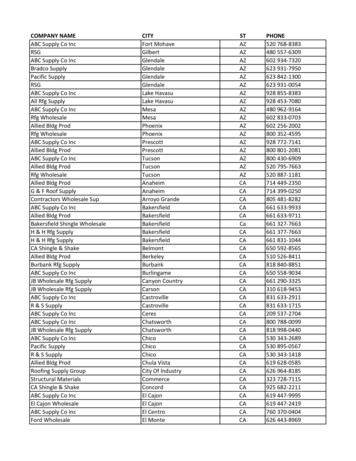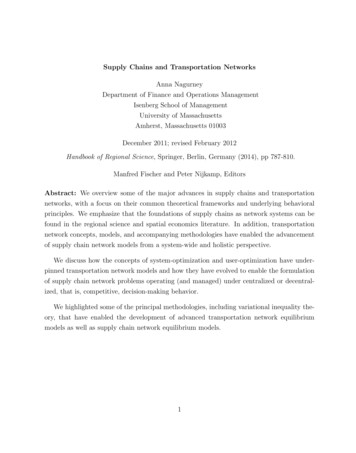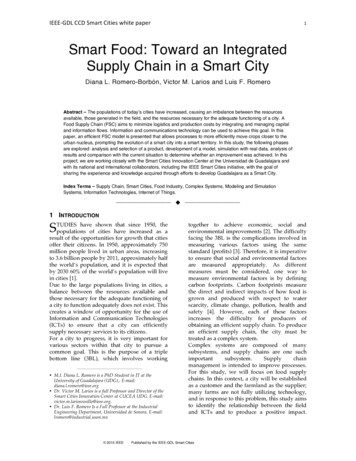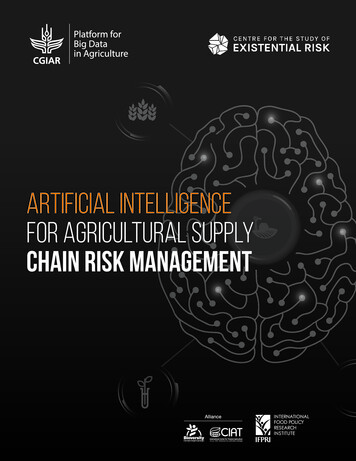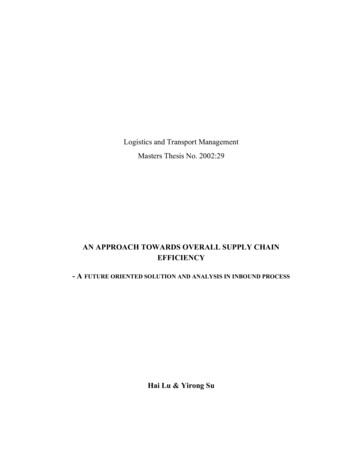
Transcription
Logistics and Transport ManagementMasters Thesis No. 2002:29AN APPROACH TOWARDS OVERALL SUPPLY CHAINEFFICIENCY- A FUTURE ORIENTED SOLUTION AND ANALYSIS IN INBOUND PROCESSHai Lu & Yirong Su
Graduate Business SchoolSchool of Economics and Commercial LawGöteborg UniversityISSN 1403-851XPrinted by Elanders Novum AB
ABSTRACTIn recent years companies and academic organizations have focused onoutbound operations due to their being the customer-oriented part of thebusiness whereas the control of the inbound operations was generally left to thesuppliers. But now outbound operations have become streamlined andextracting additional benefits has become more and more difficult. Takinggreater control of inbound logistics is becoming a top priority for manymanufacturers and retailers. Turning attention to inbound logistics will not onlyreduce costs, but also a generate more collaborative relationship with internalorganizations, suppliers and logistic providers, which will ultimately result in amore effective business process from which all parties will benefit.In our study, we tried to exploit a solution in which Schenker, as a logisticprovider, would be actively involved so that inbound logistic performance canbe more effective and efficient which would benefit all participants in the valuechain. We started by investigating the unique features of the inbound logisticsystem with a comparison of the outbound, and this was then followed by adescription of the current inbound logistic operation systems, from both aninformation flow and material flow perspective. We found that all inboundoperations can be categorized into that of traditional demand to supply model tothat of the VMI model.In approaching overall supply chain efficiency, a model hypothesis wastherefore created as a future oriented solutions. Parameters were also defined toevaluate the performance of inbound logistics. Finally, with the assistance ofthe Supply Chain Operation Reference (SCOR) model, a case study of Volvocar inbound logistic operations has been made to illustrate the merits of ourhypothesis and its improved results.Key words:Inbound Logistics, Supply Chain Management, Channel Efficiency, LogisticProcess, Outsourcing, Third Party Logistic, PartnershipIII
ACKNOWLEDGEMENTThis Master Thesis represents the essence of our achievements during the oneand-a-half years of study in the Logistics and Transport ManagementProgramme at Graduate Business School, Göteborg University. During thisperiod there have been many people who have inspired and guided us throughthe work with the thesis.We would first like to thank our tutor Dr. Peter Rosén from the BusinessManagement Department at the School of Economics and Commercial Law,Göteborg University, and our supervisor Ms. Yurina Sedano in Schenker 4Rooms, for their precious guidance and everlasting enthusiastic support.We would like to thank Mr. Jan Nordh, Managing Director of Schenker 4Rooms, for his cheerful encouragement, inspiration, and for his help in givingus such a positive working climate.We would also like to give special thanks to Professor Kenth Lumsden, atChalmers University of Technology, who helped us to break down the barriersand discover logistics in theory and practice. We truly appreciate hisrecommendation writing this thesis in co-operation with Schenker 4 Rooms.Here, we would also like to express our admiration for Professor Arne Jensen,at Graduate Business School, Göteborg University. We are proud to be hisstudents, and to have been influenced by his academic attitudes.We are also grateful to all the lovely ladies at 4 Rooms. They are Eva-BrittNilsson, Kulli Keskula, and Gunilla Jönsson, who accompanied us during ourwork, and made this time memorable.There are also many others at Schenker who have helped us in our study visitsby sharing their valuable experience to us. They are Bertil Karlsson, FredrikSöderström, Stesan Magnusson, Patrik Lind, Magnus Strand, Karl Björklund,Linda Arvidsson. Also, Mikael Warvne at Alps Nordic AB; Annika Bratt atVolvo Logistics; Jan-Olov Olausson, Martin Folin, David Stenberg in VolvoCar; Associate Professor Gunnar Stefansson in Chalmers University who helpus with the SCOR model. We hereby express our gratitude to all of them.IV
Thanks to our families and friends for their love and understanding during ourstudies in Sweden, wherever we are, you are always with us.V
Table of ContentsPREFACE .IXCHAPTER 1. INTRODUCTION . 11.1 BACKGROUND . 11.1.1 Logistic Industry. 11.1.2 Schenker AG. 31.1.3 Schenker 4ROOMS. 41.2 RESEARCH PROBLEMS . 51.3 PURPOSE OF THE THESIS WORK . 61.4 SCOPE & LIMITATIONS . 61.5 WORKING MODEL (GENERAL OUTLINE OF THE THESIS) . 9CHAPTER 2. METHODOLOGY . 112.1 RESEARCH STRATEGY . 112.2 CASE STUDY . 112.3 METHOD FOR COLLECTING DATA . 122.3.1 Primary Data . 122.3.2 Secondary Data . 142.4 RELIABILITY & VALIDITY . 142.4.1 Validity . 142.4.2 Reliability . 15CHAPTER 3. THEORETICAL FRAME OF REFERENCE. 173.1 THE LOGISTICS PLAYERS- FROM 1PL TO 5PL . 173.1.1 What Does the Numbers Mean?. 173.1.2 2PLs - Capacity Providers . 183.1.3 3PLs - Outsourced Logistics Service . 193.1.4 4PLs - Integrated Logistics Service . 193.1.5 5PLs - The Real Sense Supply Chain Management . 203.2 SUPPLY CHAIN MANAGEMENT . 213.2.1 SCM Definition. 213.2.2 Implementing Effective SCM Strategies. 223.2.3 SCM - A Framework for Analysis . 243.2.4 The Supply Chain Objectives and Principles . 263.3 SUPPLY CHANNEL IN INBOUND LOGISTICS PROCESS . 313.3.1 Inbound Logistics – What Is It? . 313.3.2 Characteristics of Inbound Logistics . 323.3.3 Inbound Logistics- A Catalyst for Supplier Collaboration . 333.4 CHANNEL RELATIONSHIP MANAGEMENT IN INBOUND LOGISTICS . 343.4.1 Channel Structure in Inbound Logistics. 34VI
3.4.2 Understanding Channel Conflicts . 363.4.3 Channel Relationship Management . 373.5 THE LOGISTICAL MEASUREMENTS . 383.5.1 Logistical Service . 403.5.2 Tied-up Capitals . 423.5.3 Logistical Cost. 423.6 SUPPLY-CHAIN OPERATIONS REFERENCE (SCOR) MODEL . 433.6.1 Background . 443.6.2 Introduction of the SCOR . 44CHAPTER 4. MODEL HYPOTHESES . 534.1 TRADITIONAL “DEMAND TO SUPPLY” MODEL . 534.2 IMPROVED SUPPLY DEMAND MODEL . 554.2.1 Vendor Managed Inventory in Inbound Process. 554.2.2 Relationship Management in VMI. 574.2.3 The Case of Volvo Car Corporation Engine . 594.3 HYPOTHESES MODEL . 614.3.1 Comparison to Different Solutions. 614.3.2 Model Hypothesis - Why It Comes? . 654.3.3 How Does It Work? . 664.3.4 The Case of Lindex- Schenker . 704.4 PARAMETERS RELATED TO INBOUND ANALYSIS . 72CHAPTER 5. A CASE STUDY: ALPS-SCHENKER-VOLVO . 775.1 SCHENKER INTERNATIONAL AB. 775.2 LOGISTICS SOLUTION . 785.3 SCORING THE INBOUND PROCESS . 825.3.1 Process Mapping . 825.3.2 Linkage Evaluation Matrix with Processes. 855.3.3 Supply Chain SCOR Card & Gap Analysis. 885.3.4 Performance Measurement . 895.3.5 SCORING the Model Hypotheses. 925.4 CONFIRMATION OF THE MODEL . 97CHAPTER 6. CONCLUSION & RECOMMENDATIONS . 996.1 CONCLUSION . 996.2 RECOMMENDATIONS . 100REFERENCE . 103ABBREVIATIONS . 109APPENDIXES . 111Appendix I: Interview Proposals . 111Appendix II A: The Store-in Process of Schenker International Warehouse . 114VII
Appendix II B: The Store-out Process of Schenker . 115Appendix IIIA: Decompose the “Source to Stock” Activities in Schenker W/H . 117Appendix IIIB: Decompose the “Delivery to Order” Activities in Schenker W/H . 118VIII
PrefaceFrom the outside, Vasagatan 46 in central Gothenburg looks like it always has a solid bourgeois apartment block for the city’s solid bourgeoisie. But do not befooled by the conservative facade, it is a center of innovative business, whereinlies the heart of Schenker’s logistics. Behind old brick walls and woodpaneling, an idea has been taking shape: 4 ROOMS – four rooms which canchange your view of Schenker along with your view of logistics. Also, in thislovely old town house close by Handelshögskolan, Gothenburg University,every time when we knock on its heavy wooden door, we had a special feelingthat Schenker 4Rooms had already strongly confirmed our decision forchoosing logistics as a future career.In every corner of the house, overlooking the elegant lanes, we nicknamed ourstudy room the 5th Room, where fresh ideas originated in the quiet and isolatedatmosphere. In this room, beginning with a logistics company, our intention isto position the logistics company in participating in the whole supply chainintegration. Since logistics service providers focus on developing specific ITsolutions to link their own systems with their clients, they can achieve fullcontrol and coordination of their product flows. Developing integrated logisticssolutions is becoming a unique methodology for logistics companies such asSchenker for achieving success in a fiercely competitive market. The studyproposes three improved models with existing case studies applied to supporteach analysis. We defined several key parameters, which affect the efficiencyof information exchange under different scenarios. In facilitating theevaluation, we also introduced the Supply Chain Operation Reference (SCOR)model for displaying comparative solutions. Encouragingly, this research resultwill facilitate Schenker in improving their Supply Chain Modeler SimulationSystem, and will also contribute to its SCOR model development for itsinbound research.We believe that a supply-chain oriented ideology is something for the future,especially for a logistics service provider who is always dedicated to achievingexcellence. Information technologies we adopted are catalysts that help tosupport and upgrade the whole process of supply chain solutions offered toIX
clients. With this dedication, clients will have easy access to efficient supplychain management, favorable business records and a competitive edge withtheir rivals.Gaining from our education at the Graduate Business School, School ofEconomics and Commercial Law, Göteborg University and our thesis work forSchenker 4 Rooms, we are proud of our studies which have helped us find thebest solutions, ideas and visions, pride and confidence. At the end of the dayyou will agree to us - an integrated logistics solution is a wonderful thing.Lu Hai & Su YirongDecember 9th,2002Göteborg, SwedenX
School of Economics and Commercial LawGöteborg UniversityChapter 1. IntroductionThis first chapter will give the reader a general view of our thesis. We startedwith the research background, which is composed of two parts, logistic industryreality and the company profile. We then approach the main problem of thisresearch and its purpose. This is followed by the scope of our study.1.1 Background1.1.1 Logistic IndustryUnder the era of globalized economy, the intensified competition pushescompanies to contract out logistics operations and cut costs in an effort toconcentrate on core competences. The logistic industry began to transformfrom the traditional transportation industry and this is continuing at a rapid rate.Logistics deals with the flow and storage of goods and related information, asdefined by the Council of Logistics Management. All the processes ofplanning, implementing and controlling the efficient, cost-effective flow andstorage of raw materials, in-process inventory, finished goods, and relatedinformation from point-of-origin to point-of-consumption are for the purpose ofconforming to customer requirements. Logistics, previously viewed as aclassical function, which involves adversarial relationships among suppliers,customers and transportation providers, is emerging as a key source ofcompetitive advantage and a leading reason for strategic alliance relationshipbetween companies and their logistics providers.According to Ross, logistics can be seen as evolution through four distinctareas: warehousing and transportation management, total cost management,integrated logistic management and supply management.1 The development ofthe logistic industry began by merely providing tactical transportation andwarehouses services to more centralized logistic functions aimed at cost controland customer services. The role of logistician then continued to expand fromtotal cost management to the integrated logistic solution providers or so called1Ross 1997, p.781
Chapter 1Introduction4PL.2 Developed based on the basis of 3PL, 4PL act as leverage to the capacityof third-party logistics providers, technology service providers, and businessprocess managers to create a solution through a centralized point of contact.3All of these developments so far are in the vertical levels or are functionallyoriented, which mainly concentrates on the outbound logistic area from theend-producer to the customer. We believe that the further development of thelogistic industry will take place in the horizontal level of the value chain.Logisticians will expand their business towards the upper stream of value chainby which the whole logistic supply chain is integrated from suppliers throughmanufacturers and all the way down to the end customers. In another words,from the outbound part penetrating into the inbound part, the centralizationeffect could be maximally leveraged.SupplierTier 2Proc Prod DistrCustomerOEMSupplierTier 1Proc Prod DistrProc Prod DistrOptimization of the whole value chainConcentration oncore competenciesOutsourcing(higher rate ofexternal processing)Cost reductionby processoptimizationFigure 1: Optimization of the whole supply chain, Source: Marcus Gaffron 2001Within the realm of business logistics, today’s changing industry dynamicshave influenced the design, operation and objectives of supply chain systemsby increasing emphasis on improved customer service levels, reduced cycletime, improved quality of products and services, reduced costs, integratedinformation technology and process flows, planned and managed movement,and flexibility of product customization to meet customer needs. 4 It has234Hieber, R., 2002, p. 35Hoffman, K.C., 2000Gophal, C., 19982
School of Economics and Commercial LawGöteborg Universitycertainly also put logistics firms to the test: Outsourcing of supply chainmanagement provides demonstrable advantages, but in many cases the supplychain itself has to be restructured if substantial savings are to be achieved.Thus, there is an increasing demand for experts capable of overseeing suchrestructuring.In the name of efficiency, information technology has been adopted to supportlogistics for many years. Recent developments in technology have broughtinformation to the forefront of resources from which forward-thinking firmscan cultivate genuine competitive advantage. The major technology behindimproved information flow was the advent of electronic data interchange(EDI). It offers greatly improved information flows and is an extremelyimportant aspect within leading organizations in the fight to decrease leadtimes. Today, the information flow has been shown to be the backbone of thelogistic system. How to optimize the information flow to leverage theeffectiveness and efficiency of the whole logistic system is one of the mostimportant areas in which the logistic providers are competing with each otherin.1.1.2 Schenker AGEstablished more than 125 years ago, Schenker is one of the leadinginternational providers of integrated logistics and freight forwarding services.Today Schenker is a Stinnes Group company. It supports the global exchangeof goods between industrial and trading companies by offering worldwide airand sea freight and associated logistics services. As a company specializing inland transport on road and rail within Europe, its closely woven network ofregularly scheduled routes connects the principal economic regions in overthirty European countries. Schenker's customers receive all of the mostimportant services from a single source - a business concept that has proven itsconvenience.With advanced traffic and information systems, high quality requirements,environmental expertise and functional logistics centers at ten locations aroundSweden, Schenker AB and its subsidiaries take an active part in making ourcustomers more competitive. In Scandinavia the head office is situated inGothenburg.3
Chapter 1IntroductionSchenker AB has a turnover of more than SEK 9 billion and is part of one ofthe largest European networks for land transport. They have a well-developednetwork of subsidiaries and associated companies in Sweden and sistercompanies in the rest of Europe.Facing the intensive competition in the logistic industry, in order to keepcompetitive, Schenker must go in the front of providing their customers withbetter logistic service but lower cost. Information, known as the backbone ofthe logistic operation, plays a central role in exploring more effective andefficient logistic solutions.1.1.3 Schenker 4ROOMS4ROOMS was launched in Gothenburg, where the core expertise in logistics,demand and supply chain management was developed in partnership withChalmers University of Technology, one of Europe’s most prestigiousuniversities in logistics and SCM.Originally, 4ROOMS was set up as an R&D function within former BTL, towhich the company's existing and prospective clients were also invited todiscuss possible improvements and future development of their businessprocesses. Over the years, 4ROOMS' academic and executive network has beendeveloped globally. Today, it is a network of leading experts and academiciansin the field of demand and supply chain management, whose expertise has beenbrought together with the aim of helping clients improve the value of theirbusinesses.5The Supply Chain Modelator is a highly powerful visual design simulation toolcreated by 4ROOMS. It is an intelligent simulation system for the solution ofcomplex global logistic projects and supply chains - in the presence of thecustomer, simulation of current logistics processes and picturing of possiblefuture processes. The Supply Chain Modelator is based on modern “nodes andlinks” logistic concept6 with powerful calculation functions that can be used tocalculate economic ordering quantities, capital tied up optimised locationplatform, etc. For each of the specific simulation cases, the user can place a set56Sources provided by Schenker 4ROOMSFundamental of logistics, Lumsden,K.R, 19984
School of Economics and Commercial LawGöteborg Universityof symbols consisting of supplier, production sites, and warehouse/crossdocking terminals, nodes and market places as well as their corresponding linksaccording to the real situation on the geographic maps. Then the initial valuescan later be entered and used on calculation for the whole case. It is a great toolwith supply chain modeling functionality, user friendly and fast in obtainingresults.1.2 Research ProblemsThe whole supply chain of a manufacturing company from the manufacturer’spoint of view can be generally divided into two parts, inbound logistics whichis from the supplier to manufacture plant and outbound logistics which is frommanufacturer to customers or even to end consumers. In the past few years, alot of studies have been made on the outbound logistic area. Since the outboundoperations have been streamlined and extracting extra benefit has become moreand more difficult, companies are turning their attention to inbound operations.In the following study, we are going to focus on the inbound logistic area andexpect to explore something new in this field.Logistics systems theoretically consist of two parts, the information flow andthe physical material flow. The information flow includes production plan,material requirements, and delivery schedules, etc. The smoother theinformation flow, the earlier information can be reached. Thus the logisticproviders can fulfill quick response according to customer requirements.Finally, the negative lead-time (lead time without any value-added) can bereduced as well as the total logistic cost. But the level of information sharing is,to a great extent, determined by the relationship among companies. Schenker,as the European leading third-party-logistic provider, is actively developingrelationships with its key accounts to improve its service level with streamlinedinformation flow. Our task is to map an ideal inbound logistic system withwhich the integrated effectiveness and efficiency can be reached so that all theparticipants in the supply chain can benefit.In order to solve the main problem of how to improve the effectiveness andefficiency in the inbound logistic system, several sub-problems need to besolved step by step. Firstly, the unique features of the inbound logistic systemare going to be studied. This will provide us with a better understanding of the5
Chapter 1Introductioninbound logistic systems. Secondly, the parameters that can be used to evaluatethe effectiveness and efficiency of the logistic system need to be selected. Thus,the potential logistic solutions could be compared with each other and theimprovement of potential solutions could be measured as well. Thirdly, it isnecessary to make case studies on mapping how the inbound logistic systemlooks like in practice, which will promise the practicability of this study.Finally, to realize the end target of optimizing the process of inbound logistics,constrictive suggestions and an optimized solution will be illustrated as ourdonation to Schenker’s simulation system.Generally, our main research problem and the sub-problems can besummarized as follows:Main problem:How to improve the effectiveness and efficiency in the inbound logisticsystem?Sub-problems:1. How is the process of current inbound logistic system?2. What parameters are going to be used to measure the effectiveness andefficiency of the logistic system?3. What kind of improvement can be made on the inbound logistic systemand how will it be after improvement?1.3 Purpose of the Thesis WorkThe purpose of our study is to explore a solution in the inbound logistic areathat may improve efficiency and effectiveness of inbound logistic system onboth information flow and physical flow where Schenker could be moreactively involved in the future. Our research result together with part of theoutbound logistics section will later be combined in upgrading Schenker’sSimulation Program in 4ROOMS.1.4 Scope & LimitationsThe scope of our thesis work is to focus on in inbound logistics process of6
School of Economics and Commercial LawGöteborg Universitymanufacturing industries, from the supply chain management’s point of view,in reducing overall cost with efficient information exchange. We areconsidering mapping an ideal inbound logistic information flow and physicalflow for key clients we shall study, which is what we are looking for in thisproject. In order to give the reader a better view or a more comprehensiveunderstanding, other relative knowledge will be involved, including forexample, relationship management etc., which could be used in future studiesbut is not included within the scope of our study.The inbound logistic of manufacturing industry, which comes from thesuppliers to Original Equipment Manufacturers (OEM), is a complicatedsystem which includes tires of suppliers and transaction of multiple semifinished-products. The level of complexity varies among different industries.The mobile industry, for instance, consists of at least five or six level ofsuppliers and hundreds of sub suppliers. The whole value chain is very muchlike a network as showed in the Figure 2. To facilitate our research, we limitour study to a one-tire relationship, from the tire-I suppliers to end-productmanufacturer.7
Chapter 1IntroductionDemand FlowProduct nesStudyScopeFigure 2: The Study Scope8
School of Economics and Commercial LawGöteborg UniversityBackground1.5 Working Model (Gen
the Supply Chain Operation Reference (SCOR) model, a case study of Volvo car inbound logistic operations has been made to illustrate the merits of our hypothesis and its improved results. Key words: Inbound Logistics, Supply Chain Management, Channel Efficiency, Logistic Process, Outsourcing, Third Party Logistic, Partnership


